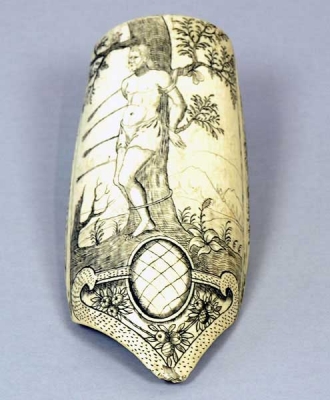Ivory arm guard (1927.24.1)
 FranceIvory arm guard from France, Europe. Collected by Charles James Longman. Given to the Museum in 1927.
FranceIvory arm guard from France, Europe. Collected by Charles James Longman. Given to the Museum in 1927.
This ivory bracer is intended to be worn on the archer's inner left forearm (the bow arm) to protect it from the string as the arrow is shot. It is cut from the outer section of the lower, hollow part of an elephant's tusk and is incised with an image of Saint Sebastian, the patron saint of archers, tied to a tree and in-filled with black pigment. It was collected at Amiens in France and probably dates to the 16th century.
Sacred Weapons
The Museum holds a number of French ivory bracers, most are elaborately engraved with coats of arms, military trophies and religious or mythological figures, often framed by floral scrolls and vines. Several, including this one, depict the martyrdom of Saint Sebastian.
According to legend, Sebastian was a Milanese officer in the Roman Emperor's personal bodyguard, the Praetorian Guard. Sebastian was discovered to be a Christian who had converted many of his troops. For this the Emperor Diocletian sentenced him to death by multiple shootings at the hands of the elite Mauretanian Archers. Incredibly, Sebastian survived and recovered to once again confront the Emperor. Diocletian finally succeeded in having him clubbed to death. Sebastian was martyred in 283 AD and his remains were moved to the church of San Sebastiano fuori le mura (Saint Sebastian Outside the Walls) in Rome around 350.
Sebastian was considered a protector against disease, and rose to his full prominence in Catholicism during the plagues of the Medieval period. Due to his ordeal, he is also the patron saint of archers, and therefore became a popular subject for depiction on a range of archery accessories.





